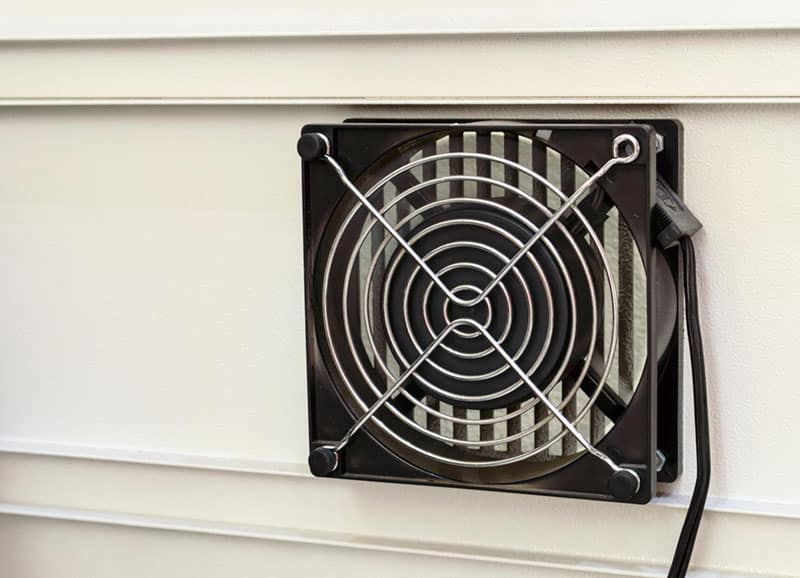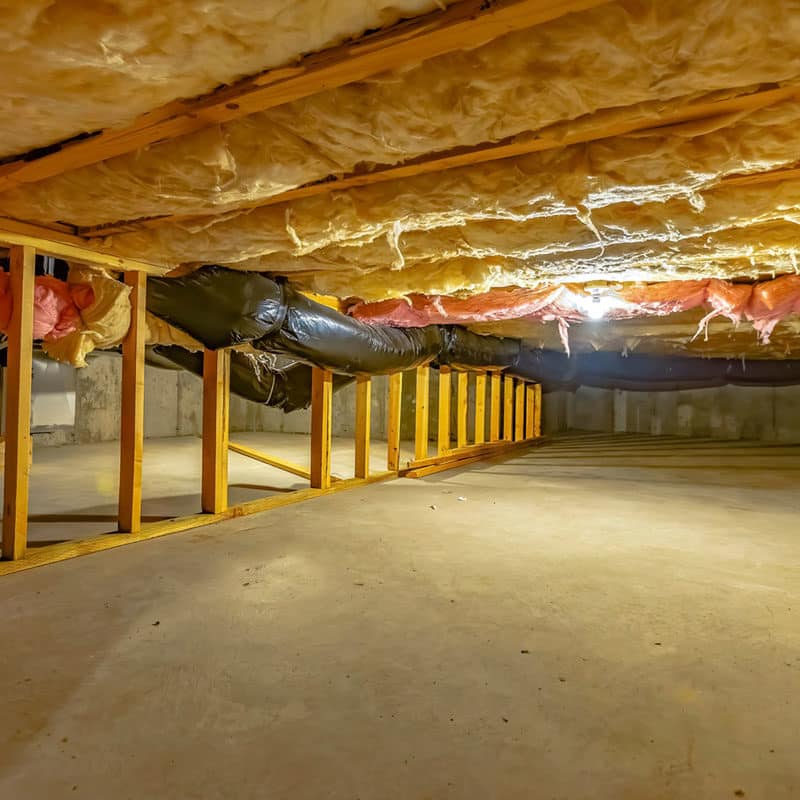Are you having a hard time deciding between a fan and a dehumidifier for your crawl space?
That’s a tough one! Ventilation is very important, especially in areas as secluded and naturally humid as a crawl space.
Both fans and dehumidifiers should do a great job at keeping dampness and mold away from this area if used properly, but which one is better for that purpose?
To answer that question, I’ve prepared the article below, where you’ll find a lot of useful information that can help drive your decision and help you make the right choice when the time comes. Here, you’ll see both appliances compared in key aspects, such as ease of installation, running costs, and more.
Keep reading to blow your doubts away!
Comparing a Fan vs Dehumidifier
Before going into the specifics, it’s always a good idea to take a look at the general picture, as it can help make everything clearer. Here’s a table showing the broad strokes of each appliance, and where each one shines.
| Fan | Dehumidifier |
|---|---|
| Less expensive to run | More expensive to run |
| Low installation cost | Higher installation cost |
| More economic long-term maintenance | Pricier long-term maintenance |
| Does not remove humidity | Most effective solution to remove humidity |
Is the humidity in your crawl space becoming a problem? Then read on to find out which ventilation method will be best for your home.
Making your crawl space a healthy environment is a tricky feat. In the summer, the humidity in the atmosphere leads to damp and mold spore growth. In the winter, the moisture in the air leads to more dampness and, you’ve guessed it, more mold spore growth. What can you do to stop the trend?
It is super important for you to install a ventilation system in your crawl space. And today, we will be considering the pros and cons of the two most popular solutions out there. Those are fans and dehumidifiers. You can find out which will be best for your home thanks to the upcoming comparison.
Fan
Are you thinking of installing a fan to ventilate your crawl space? Then we’ll consider a couple of instances where a fan may be the best choice for your home. Everything you need to know about fans and crawl spaces is coming right up.
Running Costs
When compared to the dehumidifier, a fan is the cheapest to run. The fans that are installed in crawl spaces use low-voltage technology. So, you can expect your utility bill to rise slightly after installation. But you’ll be happy to know that the price difference will not break the bank.
Installation
Regardless of whether you are fitting a fan or a dehumidifier, you will have to modify your crawl space. But fitting a fan will require considerably less work. How much work?
To fit a fan, you will need stalked liners to cover the crawl space. But that is all. The fan won’t require any extra installation. It is much simpler to install a fan than it is a dehumidifier.
Long-Term Maintenance
What about running your fan for the long haul? The great thing about fans is that they are inexpensive to replace. Finding spare parts for them is usually cheap and simple. So, if you are making your choice based on the ease of long-term maintenance, a fan is the best option.

Efficiency
In my point of view, efficiency is key. So, it doesn’t matter how cheap something is, if it doesn’t work, it doesn’t work. What can we say about the efficiency of a fan in a crawl space?
A fan may not be the most efficient ventilation solution for your crawl space if you live in a particularly damp or humid environment. This is because a fan will only circulate the air around the crawl space. So, if the air in the space is humid and moist, it will only push humid and moist air around. It will not remove moisture from the air.
The efficiency of the fan depends on your environment. It all comes down to the relative humidity in your crawl space. Once the humidity in the air rises above 60% in the crawl space, you are creating the perfect breeding ground for mold spores.
But it is not just mold that you will have to worry about. The humidity can be the catalyst for more problems like these:
- Floor joists and hardwood rotting and buckling
- An 18% less energy-efficient home
- Cold floors and dampness in the winter
Dehumidifier
So, we’ve chatted a lot about fans, but what about dehumidifiers? In which instances could one be the best option for your home?
Running Costs
When comparing the dehumidifier to the fan, the dehumidifier is the most expensive to run. In fact, they can increase your utility bills anywhere between 10 and 50 dollars per month. For some homeowners, this is just too much of a monthly shell-out for a room that no one will see or use.
Modification Costs
Before you can get your dehumidifier up and running, there is a lot of work that you will need to do. What kind of costs do you have to think about? Here are just some of them.
- Professional installation
- Encapsulating the crawl space. That is sealing off any gaps from the crawl space to the outside. This also includes the following:
- Closing off all the vents and drafts
- Solving drainage problems
- Cleaning contaminants from the space
- Reinforcing the crawl space with fiber liners and extra insulation. This often needs sealing too.
- HVAC upgrades encapsulate the crawl space to meet health and safety standards
You’ve guessed it. Modifying a crawl space to accommodate a dehumidifier is more expensive than modifying it to fit a fan.

Long-Term Maintenance
When installing a ventilation system for your crawl space, there are a lot of costs to consider. One of them that hurts the most however is long-term maintenance. How much will it cost you to run a dehumidifier in the long run?
Running a dehumidifier will cost more than running a fan. This is because dehumidifiers themselves are more expensive. And when something goes wrong with them, they are not cheap to repair. Spare parts are pricey, and their installation is too.
What if your dehumidifier needs replacing? To buy a new dehumidifier for a small crawl space, you are looking to spend about $200/$300. But a dehumidifier for a larger space will set you back a lot more.

Efficiency
Up until now, you may wonder if there are any instances where the dehumidifier comes out on top when compared to a fan. But there are when you consider its efficiency. A dehumidifier will get the job done better than a fan. Now, you may be thinking, well, that’s a rather sweeping statement. So, take a look at what I’m basing this on.
Unlike a fan, a dehumidifier will do more than circulate air around the crawl space. It works to remove moisture from the air.
When you have a dehumidifier installed, the crawl space is modified. This is so that outside air cannot infiltrate the space. This means that the cold and damp air in the winter will not enter the crawl space. This will help you prevent a whole host of problems such as these:
- Cold flooring and drafts in the winter
- Expensive utility bills
- Floors and beams buckling from a damp basement environment
What problems will it help you avoid in the summer? When you install a dehumidifier, the humid air is blocked from entering the crawl space. All of this keeps the environment at bay and means that the dehumidifier does not need to work as hard. The dehumidified environment cuts down on odors and helps to keep the house fresh.
Conclusion
We’ve seen a lot about the differences between fans and dehumidifiers. But which is the one for you?
You should choose a fan if:
- You are searching for a solution with the cheapest running costs.
- You want a ventilation system with the most economical installation.
- You are looking for an easy and inexpensive long-term maintenance plan.
You should choose a dehumidifier if:
- You are looking for the best solution to take humidity out of your crawl space even in humid or damp climates.
Has this article been helpful to you? Then why not check out some of our other articles and free guides? You could even sign up for our email list.
Have a great day!
—Craig.
Frequently Asked Questions
Can a Dehumidifier Cool a Room?
Not really. At least not directly.
A dehumidifier’s main purpose is to remove excess moisture from a specific area in your home, so it has no cooling capabilities.
That being said, humid areas tend to trap more heat and make a room feel hotter, so by removing excess humidity, you might feel a little cooler and more comfortable overall.
Are Dehumidifiers Good for Allergies?
Sure, but don’t rely solely on it.
While the moisture dehumidifiers remove can help keep things like mold, dust mites, and other allergens in check, it should only be one part of a larger treatment plan if your allergies are severe.
Can a Dehumidifier Make a Room Too Dry?
Absolutely.
Ideally, you’ll want to use a dehumidifier in places with a lot of moisture. If you use one of these appliances in an area that’s already very dry, it can cause some issues, such as dry skin and even nosebleeds.
Several environmental authorities recommend keeping humidity levels between 30-50% at all times.
Can a Fan Be Used to Dry a Carpet/Upholstery?
Technically yes, but there are better alternatives, such as fan blowers.
These appliances are specifically designed to be placed in an area and dry carpet and other objects in your home. So, if you’re really interested in this, make sure to check them out.







